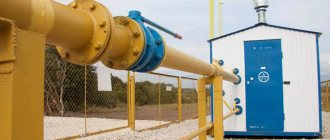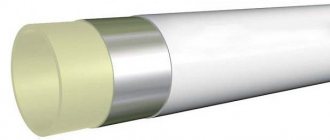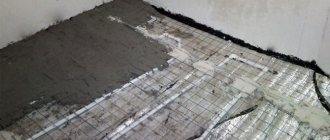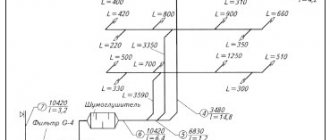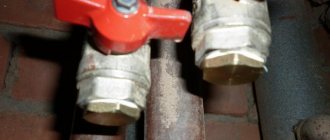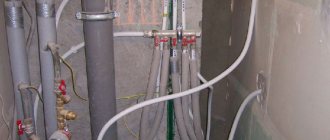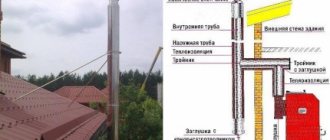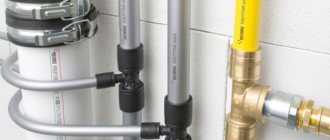A plastic pipe for gas is a relatively new type of equipment. It is increasingly used for supplying and transporting fuel material on the site of a private home or in commercial buildings. This equipment has many advantages, but before using it on your site, you should familiarize yourself with certain features of the product and installation instructions.
Plastic pipes for gas have many advantages over metal ones, but they are only allowed to be laid underground
A high-quality gas pipeline for a private home: what does it consist of?
Gasification in a private cottage is a complex and labor-intensive process. It requires maximum precision, accuracy and professionalism. If you need to build or repair gas communications, it is better to seek the help of specialists. It is very important to follow all safety precautions and ensure that the structure and its installation/repair comply with all fire safety requirements.
The gasification scheme in the house includes the following elements:
- gas holder – a special tank for storing gas;
- fuel supply pipes;
- gas boiler, water heater, gas stove, fireplace or other consumer appliances.
When arranging this system, the correct choice of gas pipes is important. It depends on what working volumes of the gas pipeline you are counting on, what type, soil condition and corrosion activity in the area, as well as how much you are counting on.
Helpful advice! It is better to use the services of specialists to determine what material the gas pipeline elements should be made of - metal or plastic. For this, there are certain requirements for gasification and state standards.
Gas supply to the house must be carried out in compliance with safety measures, and the choice of pipes plays an important role here
Advantages of plastic
Lately, plastic gas communication equipment has become very popular. The material itself was invented relatively not so long ago, and it began to be used in construction and repair work even later. However, now it is in demand, as it has advantages compared to its metal counterparts.
Firstly, pipes made from it are not subject to corrosion, which is the main weak point of iron products. Plastic pipes for gas pipelines do not require additional protection and insulation also because they do not conduct current and are resistant to the negative influence of the environment and various types of organic and chemical aggressive substances. In addition, they do not require cathodic protection.
Secondly, a plastic gas pipe functions successfully even with frequent changes in temperature, but not under extreme conditions.
In addition, such a pipe is very durable and strong, which is ensured by the uniform structure and performance characteristics of the material itself. The warranty period reaches 50 years.
Gas pipes made of plastic are convenient and easy to install, they are easy to transport to the work site
Another advantage is their versatility. Due to their plasticity, pipes can be used in the construction of gas pipelines of the most complex design and in the most inaccessible places and unfavorable natural conditions.
Brands of polymer pipes
The most common types of plastic pipes for gas include:
- High and low pressure polyethylene pipes
. The brand of products intended for gas transportation is indicated by a yellow stripe. The products are suitable, in addition to gas transfer, for the installation of sewerage circuits and cold water supply. - Polyvinyl chloride pipes
. They are distinguished by greater strength compared to the previous type. Suitable for gas supply and sewerage systems. They are not used as water supply elements, since upon contact with incoming water they release chlorethylene, which is hazardous to health. - Polypropylene pipes
. Polypropylene is the best option for making gas pipes. It is tougher than polyethylene, does not emit toxic substances like polyvinyl chloride, and does not interact with most aggressive environments. Thus, products made from this material can be used in almost all types of home communications.
The listed materials have their advantages and disadvantages.
For example, small-diameter pipes made of polypropylene and polyethylene are produced 50-500 m long in the form of coils; they weigh 2-4 times less than steel products.
Features when compared with steel analogues
In addition to the advantages, any product has certain disadvantages, and plastic pipes for gas pipelines are no exception. Before installing them, please note that installation of such structures is impossible:
- Ground and above ground. Plastic pipes for gas are designed for underground communications located inside the ground.
- In areas of increased seismic activity. This applies to areas where the activity level reaches 6 points.
- Within the city in high-pressure gas zones (in gas pipelines of categories 1 and 2).
- In enclosed spaces, residential, commercial and industrial buildings, sewers. Here it is customary to use mainly steel structures.
- A plastic gas pipe is inferior to a metal pipe in terms of strength characteristics.
If you compare plastic pipes for gas pipelines and steel communications, you can notice some significant differences:
- Price. Since steel pipes require additional electrical insulation and protective layers, installation and maintenance take more time and money. And the prices for steel are slightly higher than for plastic products.
- Weight and transportation. Steel equipment weighs much more, making it difficult to transport. In addition, polyethylene products are transported in coils, which makes them more compact.
- Versatility. If everything is simple with a plastic gas pipe in a private house, then steel products must be used strictly taking into account temperature, landscape conditions, and operational parameters. Depending on this, the required thickness and design features are selected.
- Installation. A steel pipeline is somewhat more difficult to install than a plastic one.
Despite all the advantages of plastic gas pipes, their use in high-pressure gas pipelines is prohibited
When choosing the right material, be sure to take into account the above differences and features.
Rules and features of gas pipeline installation
employees of special services have the right to install and adjust the gas pipeline . Independent connection or installation is strictly prohibited. In addition, it is necessary to first draw up and approve a gasification project.
Building codes
Main gas supply diagram
When drawing up a project , choosing a location for a boiler or stove, you need to remember that gas pipes are laid in compliance with SNiP standards . The provisions are as follows:
- It is prohibited to install a gas pipeline under a window or doorway, or under a ventilation line;
- a distance of 50 cm must be maintained from the pipe to the electrical panel;
- there must be a distance of at least 25 cm between the gas line and any electrical communications;
- the gas pipeline is mounted on the wall at a distance of 22 cm from the floor, with sloping ceilings - at 20 cm;
- equipment can be connected using a flexible hose with a cross-section of 10 mm;
- It is prohibited to place water heaters in the bathroom;
- the distance between the stove and the pipe should be less than 80 cm;
- the gas meter is mounted at a height of 160 cm from the floor and at a distance of 80 cm from the boiler or stove;
- Separate holes are made in the wall for the gas pipe and ventilation;
- the line is installed at an angle of 3% from the gas meter to the equipment.
Access to communications must be open. Even if they are hidden in a box, the latter must be removable.
External pipeline
External gas pipeline
The gas network is almost always laid underground. This option eliminates mechanical damage, gas leakage, and reduces the danger to the environment. In some cases, overhead installation up to the walls of buildings is allowed, as well as in certain sections of the route. The height of the above-ground gas pipeline is determined by technical conditions.
Placement in sewers, tunnels and channels is not allowed. The only exceptions are networks on the territory of industrial enterprises with a pressure of 0.6 MPa.
All connections must be welded , with the exception of the joining of metal and plastic pipes. At the point where the gas pipeline enters and exits the ground, as well as when passing through the walls of a building, it is placed in a case. It is preferable to introduce the gas pipeline immediately into the room where the main gas equipment is installed.
In front of gearboxes, before entering buildings, on branches and other areas, disconnecting devices must be installed.
Home gas network
Example of a project
Intra-house networks are designed for pressure from 0.3 to 0.6 MPa. Plastic options are much more often used here, since they are cheaper and allow you to equip the system without transition elements. Additional restrictions on the internal network are as follows:
- installation of a gas meter is required;
- Only 2- or 4-burner models that comply with GOST are installed in the home;
- the water heater, as well as other air heating devices - boiler, boiler, must be equipped with automatic equipment to turn off the gas supply when the pressure drops critically.
Gas pipes can be hidden in grooves, but only if they are covered with removable panels.
Mikhail Viktorovich
Our construction guru
Ask a Question
Gas pipes are often connected by welding. This method ensures the tightness of the joint and the strength of the resulting line. Flange or threaded connections are allowed in places where gas fittings are connected. To ensure tightness, the threads are sealed with flax and coated with paint, like red lead or white lead.
Crimping
Pressure testing is carried out when launching new equipment or after repairs.
Before delivery of the finished gas line, control work is carried out - pressure testing . The same procedure is performed during a scheduled system check.
Pressure testing is carried out only by specialists and only after control testing and inspection of gas equipment. The essence of the procedure is this: after installing special plugs, air under pressure is pumped into the system and pipes, seams, and connections are examined . If the seal is broken, air is released in this area and can be detected. Identified defects are eliminated and crimping is repeated.
Commissioning works
The procedure is performed after crimping and testing the equipment. It includes:
- equipment adjustment;
- testing of automatic control device and safety system;
- thermal insulation of structures and auxiliary equipment;
- determining the best operating mode.
The test run is performed using reserve gas or main gas. When starting the gas, you need to blow the pipes through the holes in the burners to completely displace the air. Check the system for leaks. Then they test the operation of the pressure gauges and react to the draft of the gas boiler. Before ignition, the firebox and flues are ventilated. If during ignition there is a breakthrough or separation of the flame, the gas supply is stopped, the burners, furnace and flues are purged again and ignition is performed again.
Types of plastic pipes
Depending on the material, plastic pipes come in different types. Each variety has its own characteristics and specifics, which must be taken into account when laying communications.
The first type is low and high pressure polyethylene pipes. There are two brands of such pipes, visually distinguished by a colored stripe. Gas ones are marked in yellow. This type of equipment is distinguished by its affordable price, light weight, and elasticity. This option is also suitable for installing communication systems for cold water supply and sewerage.
The second type is polyvinyl chloride pipes. This is a more stable design, but its use in water supply systems is not recommended, since when interacting with certain substances it releases the toxin chlorethylene. But for sewerage they are quite suitable as a replacement for cast iron pipes.
A safer option is polypropylene. It is practically inactive when interacting with chemicals. This gives it the same advantage that metal-polymer pipes have - versatility. That is, it can be used in different types of communication systems, including gas supply.
The most common type of gas pipes made of polymers are products made from low-density polyethylene
Characteristics and use of steel pipes
Nowadays, steel gas pipelines are the most common. This is due to the high reliability of the material and a wide range of applications.
General description of steel products
The requirements of gasification building codes are met by welded pipes with a spiral or straight seam or seamless hot or cold rolled products. They are ubiquitous and are used in the construction of both main pipelines and connection lines to private homes.
For the manufacture of steel pipes used for gasification, low-carbon steel (up to 0.25%) is used. Sulfur (content no more than 0.056%) and phosphorus (content no more than 0.046%) are removed from it. This is necessary to give the material the required properties.
The main parameters of the pipes are the thickness of the steel wall and the diameter of the gas pipeline, which are determined by calculation and depend on the volume of gas pumped and the pressure in the system.
In addition to the calculated values, rolled steel pipes must comply with GOST, the main requirements of which are the following parameters:
- the diameter of the internal gas pipeline must be 25 mm or more;
- pipe diameter for installing gas distribution systems - 50 mm;
- for the construction of an above-ground gas duct, it is permissible to use a product in the manufacture of which steel with a thickness of 2 mm or higher is used;
- The thickness of the steel of the underground gas pipeline must be at least 3 mm.
In addition to the method of laying the gas pipeline, the diameter and wall thickness of steel products can be influenced by seismic and climatic features of the territory where construction is taking place.
Marking of steel pipes
Any specialist must understand pipe markings, since behind a set of simple letters and numbers lies important information. So, the abbreviation VGP means that in front of you is a water and gas pipe, the manufacture of which must be regulated by GOST 3262-75.
The main parameter of a gas pipe is the nominal diameter, marked as DN. For manufactured products with a diameter of 6-150 mm, the standard wall thickness is in the range of 1.8-4 mm. Reinforced pipes are produced industrially. For their manufacture, steel is used, the thickness of which can exceed 5.5 mm.
The marking is present directly on the pipe, the thickness of which is more than 3.5 mm, and the DN exceeds 159 mm. Otherwise, a package of products is marked, on which a label is posted containing information about the length and diameter, and the grade of steel used. The manufacturer's quality control mark must be present on the label.
The letters in the marking of steel pipes correspond to the following parameters:
- P – high precision steel;
- N – presence of rolled thread;
- P – presence of cut thread;
- D – extended thread;
- M – equipped with a coupling.
The standard length of VGP steel pipes is 4-12 m. They are called dimensional. With a length of more than 12 m they are called unmeasured.
Features of steel gas pipelines
Thin-walled lightweight steel pipes are used exclusively in low-pressure gas pipelines, which are used in the gasification of private houses and in the construction of intra-apartment wiring. The low weight of the material makes it easier to work with pipes and allows you to easily lay a network characterized by complex structural features.
Lightweight products can be bent at a slight angle without using a pipe bender. Steel pipes with thin walls have high thermal conductivity, which often leads to the formation of condensation.
Premature aging as a result of corrosion can be avoided if, after installing the pipeline, their surface is treated with oil paint. The more layers of it are applied, the more effective the protection of the steel will be. Such products can be easily connected by soldering, and threaded connections using fittings are also allowed.
If it is necessary to install a gas pipeline that can withstand the highest possible pressure, it is customary to use more massive, thick-walled, reinforced pipes. The highest strength of a gas pipeline is achieved with high-quality connection of seamless steel pipes by welding; at the final stage, control of the connections is required.
Advantages and disadvantages of designs
Steel products, due to their physical properties, are characterized by high strength, and high-quality welding work ensures the reliability and tightness of the seam. They can be considered universal due to the ability to perform above-ground and underground installation. And they are also suitable for both indoor and outdoor use.
Along with the positive aspects, there are also a number of disadvantages that cannot be ignored when choosing pipes and taking measures to optimize the service life of steel gas pipelines:
- complexity of installation work;
- low corrosion resistance;
- tendency to form condensation, which is especially active in light pipes;
- high weight;
- high cost;
- poor flexibility.
If construction standards, installation and operation rules are observed, and high-quality insulation is ensured, the time of uninterrupted operation of a steel gas pipeline will be at least four decades.
Pros and cons when comparing metal-plastic and polyethylene pipes
Transporting small-diameter plastic or polyethylene pipes is equally easy. They are produced in coils of 50-500 m and weigh 2-4 times less than their steel counterparts.
Butt welding of gas plastic pipes is also cheaper than in the case of steel ones. This does not require additional consumables. And the process itself is much simpler and faster. You can use thermistor couplings, which will also simplify the installation procedure. Such a pipeline can be laid by pulling. And it will serve for a long time, without requiring frequent intervention and repair, also thanks to the smooth and elastic inner surface. Thick-walled polyethylene pipes can be used for gas pipelines of the third and sometimes even second category.
However, there are some differences between these types of material:
- at extremely low temperatures, gas polyethylene pipes lose their operational capabilities and may break;
- PVC pipe is more durable and safer in terms of reaction with chemicals;
- polyethylene is not resistant to the negative effects of ultraviolet rays, so you need to install a plastic gas pipe underground, and not in an open space or in a lit room. Otherwise, this may lead to a decrease in service life and negative consequences. But for PVC pipes this limitation is not relevant;
- Polyethylene pipes can only be laid outdoors in the soil to protect equipment from mechanical damage, while metal-plastic pipes are more durable.
A metal-plastic pipe has greater strength than HDPE, and it can be used where it is not possible to install a hidden pipeline
Requirements and recommendations for laying gas pipes underground
Regarding the above-ground installation of gas pipes, the installation of underground gas pipeline structures is quite expensive. However, this does not reduce the demand for underground gas pipelines. They are less dangerous, better protected from damage and do not spoil the aesthetic appearance of the site. There are also rules and conditions for laying such highways:
- If the soil corrosion test on the site gives a positive result, it is better not to lay the gas pipeline underground. But the presence of high-voltage wires nearby, on the contrary, is a strong argument in favor of an underground structure, but then the pipes are covered with insulation;
- When laying a polyethylene gas pipeline, high-strength products (PE-80, PE-100) are used. Flexible pipe PE-80 can safely serve systems whose operating pressure does not exceed 0.6 MPa. For systems where the pressure is from 0.6 MPa to 1.2 MPa, it is better to use PE-100 pipes and connecting elements or steel pipes. The depth of installation underground will be at least 1.0 m;
- The use of reinforced polyethylene pipes and connecting elements between them is permitted when laying gas pipelines, the pressure in which will be more than 0.6 MPa. The permissible laying depth underground will also start from 1.0 m;
- on lands intended for arable work, as well as in abundantly irrigated areas, the initial depth of laying the gas pipeline will be 1.2 m.
Knowledge of these requirements for high-quality laying of a gas pipeline underground will help you correctly install gas pipes with your own hands, as well as monitor the actions of workers in order to avoid mistakes that lead to negative consequences.
Source
What to consider during installation
Before you begin installation work, make sure whether plastic pipes for gas can be used on your site. To do this, you should pay attention to some points.
A gas pipeline made of polymer pipes can only be laid using a hidden method. Polyvinyl chloride has a low expansion rate, so feel free to install pipes in concrete or specially equipped adits. However, not too tightly, but rather using an insulating soft material so as not to damage the pipe.
Helpful advice! Remember that the fewer fittings, various connecting and butting elements, and accessories you use, the more stable the pressure will be. This means that energy costs for fuel transportation are also reduced.
Use pressed or crimp fittings to connect pipes. Draw up a diagram in advance according to which the plastic gas pipeline will be built. Make sure that it is approved by the relevant authorities. It’s better not to try to do the work yourself, but turn to specialists for help. Remember that equipment for supplying and transporting gas is a dangerous thing and improper installation or maintenance can result in tragic consequences for you and your loved ones.
The feasibility of using metal-plastic pipes in gas pipelines
Metal-plastic pipes are widely used for heating and water supply. Today, many countries are considering the possibility and feasibility of their use in gas transmission systems.
Today, steel and copper continue to dominate the gas industry. The market has been waiting for a long time for an alternative reliable material that provides ease of installation work, high safety and reliability.
Gas pipeline arrangement diagram.
The main disadvantages of carbon steel gas pipelines are the complexity of installation (including the need for qualified welders), susceptibility to corrosion processes at points where they pass through walls, and considerable maintenance costs.
Metal-plastic pipelines for gas supply provide:
- The long service life of metal-plastic pipelines and connections is from 50 years, and second-generation pipes can be used for more than 100 years.
- Simplicity of installation work and low weight of elements in comparison with other pipelines.
- Greater throughput due to the absence of roughness in the inner layer of pipes.
- Highly economical - when installing gas pipelines, a minimum number of fittings is required due to the ability of the pipe to retain its shape when bent.
- Versatility: crimp profiles for TN press fittings;
- Large range of pipe diameters and fitting sizes for connecting various gas equipment.
- Metal-plastic pipelines can be laid hidden, and this allows gas to be carried through residential premises and gas equipment to be installed anywhere in the room.
Methods for connecting elements of communication systems
The plastic pipeline should be installed underground or in another environment (hidden method). Pipes are connected mainly by welding.
Welding of plastic pipes is carried out using a special welding machine, its type depends on the chosen welding method
There are three main welding methods:
- Electrofusion. A plastic gas pipe melts under the influence of current and is connected to another using a fitting. This technique is used for polypropylene and polyethylene gas communications.
- Stykova. This method is used to connect all types of plastic pipes with a diameter of 5 to 16 millimeters.
- Socket This is a type of welding primarily intended for the repair and installation of sewer and water supply systems. They connect pipes with a diameter of 15 to 90 millimeters.
As for plastic pipes for gas in a private house made of polyvinyl chloride, they are connected to each other using glue. You should not be skeptical about this type of fastening, since modern technologies make it possible to produce durable adhesive that provides a strong connection for several decades. This method is more convenient and does not require special equipment or special conditions for the soldering process.
How is a metal-plastic pipe constructed?
Production technology
The metal-plastic pipe is made of aluminum, with an outer and inner protective polyethylene layer. Pipes are welded with butt seams using a laser or lap seams using ultrasound. Rust and salt deposits do not accumulate in such pipelines due to the smooth inner surface coated with plastic. It follows from this that the possibility of leakage is practically zero. The outer protective layer of plastic protects the aluminum pipe from minor mechanical damage and condensation. Layers of polyethylene and aluminum are connected using special glue. Different manufacturers use their own glue. The strength, flexibility and durability of the pipeline directly depend on its quality, and for this reason, manufacturers do not disclose the secret composition of the magic glue. If the adhesive loses its elasticity, the pipeline may delaminate and begin to leak.
Structure of metal-plastic pipes.
The production technology makes it possible to produce metal-plastic pipes with a very small diameter, which is another significant advantage that expands the scope of their use. When performing hydrostatic calculations of heating or plumbing systems, the engineer sets the diameter of a steel pipe one third larger than that of a metal-plastic pipe. It is very difficult to produce small-diameter steel and plastic pipes. Steel has insufficient flexibility, and plastic has low thermal conductivity, so “warm floors” became available only when metal-plastic appeared. Another advantage of these pipelines is their versatility: they can be used both inside and outside the building.
Structure of metal-plastic pipes
The metal-plastic pipe has the following structure:
- Polyethylene layer.
- Adhesive substance.
- Aluminum layer.
- Adhesive substance.
- Polyethylene layer.
Technical characteristics of metal-plastic pipes
- The working pressure is 1 MPa.
- The burst pressure is 4-6 MPa.
- Hydrostatic long-term pressure is 2.1-2.7 MPa.
- The minimum bend radius is 8-16 cm.
